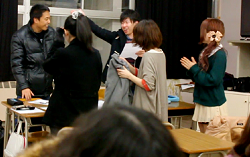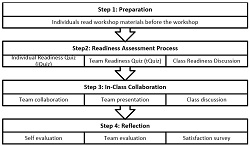Influence of the Hawthorne Effect on performance
Because of direct researcher engagement in administering the research cycles, organizational psychology scholars may question whether performance improvements during Team Hachi Project were skewed more by the Hawthorne Effect than by the team learning methods used for the action research (Jex & Britt, 2014).
The Hawthorne Effect is a concept that emerged from seminal organizational psychology research at the General Electric Hawthorne Works factory in the 1920s. The Hawthorne researchers attempted to assess the influence of environmental variables on worker productivity. Manipulating lighting, temperature, assembly line speed, and other environmental variables, worker productivity tended to increase regardless of the change. Further analysis suggested that the variables were mainly irrelevant. A combination of the attention workers received from the researchers and the social environment created by the project influenced productivity more than environmental manipulations (Adair, 1984; French, 1950).
Although the Hawthorne studies spawned the human relations movement and organizational psychology field (Jex & Britt, 2014; Bateman & Snell, 2007), the Hawthorne Effect is not necessarily a positive aspect of group dynamics because it can disguise research results and temporarily mimic change. This suggests two potential limitations for Team Hachi Project results.
- Performance improvement may occur just by paying attention to people, not by what they are learning.
- Performance increases may be temporary consequences of an attention event. For example, when the boss enters a manufacturing floor, workers may have a sudden burst of productivity as they respond to the alert, “The boss is coming; look busy!” When the boss leaves the floor, the attention event ends. Social homeostasis activates with the boss’ departure, and worker productivity drops below pre-attention event levels.
Applied to Team Hachi Project, critics peeking through the Hawthorne Effect might perceive that researcher observations and engagement influenced behavior more than the small-group learning methods they introduced. However, this perception may obscure the understanding that the Hawthorne Effect can be a valid tool in a collaborative action research project, the classroom, and the workplace. In Team Hachi Project, researcher observation and engagement became tools for scaffolding individual and team development. The instructors intentionally implemented varying levels of attention events to influence student engagement, performance, collaboration, and independence (see Table 1).
Essential differences between Team Hachi Project and the Hawthorne Studies are that Hawthorne researchers (Adair, 1984; Jex & Britt, 2014):
- Attempted to manipulate environmental variables but were oblivious to how their presence influenced subject behaviors.
- Did not attempt to intervene directly in worker practices.
- Did not provide workers with training or tools that could enhance productivity.
In comparison, as collaborative action research, Team Hachi Project did the following:
- Acknowledged and leveraged the researcher as an active mentor who influences participant behavior to improve processes and solve problems.
- Actively engaged the subjects as participants in influencing the development of the study as it progressed.
- Intentionally leveraged attention events to provide substantial instruction, feedback, and tools.
- Facilitated collaborative methods among teachers, students, and groups to influence development at all levels of a dynamic learning system.
Also important, as an action research project that engaged researchers as managers to solve a problem (Ferrance, 2000; Lewin, 1946), Team Hachi Project used student survey data and classroom observations to identify opportunities for improving subsequent cycles. This helped to validate the influence of variables—including researcher involvement—on substantial and durable change.
Table 1. Instructors can leverage attention events as intervention tools to improve students' performance and satisfaction.
 |
 |
| Instructors plan the next series of attention events while teams collaborate. | The instructor observes team activity to identify intervention opportunities. |
 |
 |
| The instructor in the foreground explains a challenging concept while the instructor in the background observes another team. | The instructor coaches a team on using a worksheet as a collaborative tool. |
 |
 |
| The instructor celebrates a student’s correct answer to a challenging question. | The presence of recording equipment is a persistent attention event that motivates performance while capturing data. |



